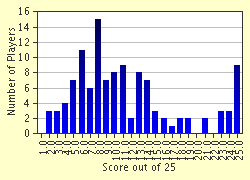Quiz Answer Key and Fun Facts
1. On October 21, 1910, Canada's navy came into being. What was its name at the time?
2. Though HMCS Rainbow would be Canada's first Naval vessel, commissioned on August 4, 1910, this ship was the first commissioned for 'active' duty.
3. The RCN (Royal Canadian Navy) by name came into existence when?
4. In which year did the Royal Canadian Navy (RCN) cease to operate under that name, only for that decision to be reversed 43 years later?
5. During the inter-war years, with budgets slashed, what was established to maintain the Royal Canadian Navy's (RCN's) manning requirements?
6. Though never a major player in the submarine community, Canada's Navy has always delved into submarine technology. What were the names of Canada's first two submarines?
7. Canada's first Naval loss of World War II occurred on June 25, 1940 when this destroyer collided with the Royal Navy cruiser HMS Calcutta while hastily evacuating personnel from the French port of St Jean de Luz. Which was it?
8. As part of a lend-lease deal (ships for bases) between the US and Britain in 1940, the Royal Navy received 50 old 4-stack USN destroyers in return for establishing bases on Commonwealth soil. A number of these were turned over to the Royal Candaian Navy (RCN) for Atlantic escort duties. How many?
9. November 6, 1940 saw the first contact for the Royal Canadian Navy with the enemy at sea. This destroyer, along with the RN destroyer HMS Harvester, depth charged and sank the Italian submarine Faa di Bruno.
10. Another first saw this destroyer become the first Canadian vessel of the war fired upon by an enemy vessel.
11. The bulk of Canada's wartime Navy comprised this class of vessel.
12. Though records are still sketchy, one of the first attempts by the Allies to gain the ULTRA secret at sea occurred on September 10, 1941 when this corvette encountered U-501 south of Greenland.
13. On August 27, 1943, this destroyer in company with an RN Task Group was the first Allied ship attacked by a new breed of German 'smart bomb'.
14. "Canada's Fightingest Ship", this Tribal Class destroyer has found a permanent home on the waterfront of Hamilton, Ontario.
15. At the end of hostilities in 1945, Canada's Navy ranked here in the largest Allied navies.
16. Referred to as 'Cadillacs' when introduced into service, this class of destroyer was Canada's first post-war attempt at a fully designed and developed warship purely Canadian.
17. This destroyer was the only RCN vessel to be struck by enemy fire during the Korean War.
18. This vessel was the flagship of the Royal Canadian Navy through the late 1940s and into the 1950s.
19. Dubbed "Sisters of the Space Age", this destroyer class developed in the 1960s joined the Canadian Navy in the early 1970s.
20. Canada recently leased four of this class of submarine from the British government to replace the aging submarines acquired in the 1960s.
21. These two unique vessels provide at-sea replenishment for Canada's current Naval Fleet.
22. Only one ship in the Canadian Navy has ever carried the designation DDG (Guided missile destroyer). Which is it?
23. This twelve-ship class of Coastal Patrol vessels began appearing in Canada's fleet in the mid 1990s.
24. This 'Halifax' class frigate, during operations in the Persian Gulf on the War on Terrorism, boarded and confiscated a dhow carrying over $50M USD worth of drugs in early 2002.
25. Finally, an easy one. Canada's West Coast Fleet is currently based out of ...?
Source: Author
Pat in Halifax
This quiz was reviewed by FunTrivia editor
bloomsby before going online.
Any errors found in FunTrivia content are routinely corrected through our feedback system.

